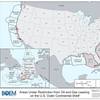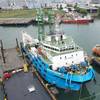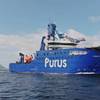Air dropable, ship deployable and multi-mission configurable, big things do come in little packages. Northwind Marine’s unmanned surface vehicle (USV); the “SeaFox” is a little package delivering multiple capabilities for the expanding requirements of fleet and port security.
Originally commissioned through the Office of Naval Research (ONR) Tech Solutions Program for towing air gunnery training targets at 40 knots, the 16-ft x 5-ft Northwind Marine Inc. engineered, alternative fuels USV, is compact and capable of carrying relatively large payloads.
“The SeaFox can easily handle 600 pounds of additional gear,” said Bruce Reagan President of Northwind Marine Inc. “Together, the swimmer detection, cameras, radar total far less weight than what can be put into this boat.”
“No question there is a huge need for autonomous target towing at sea. The SeaFox is just a commonsense platform that you can’t help but explore other options. This is why Northwind Marine Inc. is taking its own initiative and moving it to the next level.”
Other potential applications include pre-fire weapons range clearance, location inspection for reconnaissance teams, night surveillance, data relay and commercial fishing support, Reagan said. In conjunction with other industry leaders in the marine and unmanned air vehicle electronics fields, Northwind Marine Inc. is working on several electronics packages that fulfill a wide range of mission functions.
“The surveillance and intelligence applications are endless,” he added. “You can sit in your Seattle office with your laptop, drive around New York harbor and see if anyone is swimming around or watch the dock workers.”
“We’re not trying to reinvent the wheel, just put together mission specific packages that can do what is needed to save lives and, although I hate to use the term, build it to whereas it’s almost ‘disposable’ in comparison to other USV’s.”
The SeaFox is a small platform and due to its size may limit potential for personnel delivery, Reagan admits. This is easily overcome, he added, because Northwind Marine Inc. manufactures 17 different Aluminum-hull Rigid Inflatable Boats (A-RIB) and similar autonomous capabilities can be integrated into vessels as large as 56-ft. Reagan favors integration into Northwind Marine’s 17-ft, 24-ft and 36-ft A-RIBs.
Although existing SeaFox USVs are in use, Northwind Marine Inc. is planning to demonstrate the most recent version at the 2004 Multi-Agency Craft Conference (MACC) in Norfolk, Va. June 15-17. Electronics will include a through-hull deployable swimmer detection system, a controlled self-stabilizing, high-resolution camera, a multi-configurable laptop controlled guidance system and a hailing system to broadcast warnings and alerts.
Also under development is a remote control single point launch and retrieval system. If the prototype system is finished by June, it will accompany the SeaFox to the MACC. This will make ship board deployment possible with a minimum amount of staff and eliminate the need to launch a recovery boat for retrieval.
The first SeaFox was introduced at the 2003 MACC. Designed to operate at 40 knots in sea state 3 with a 200-hp JP5 engine, the vessel is built in accordance to ABS specifications and welded to US Coast Guard inspection standards. Along with Northwind Marine’s proprietary all-welded, slot-woven integrated framing, the ¼” inch aluminum hull plating can withstand the abuse of constant full-throttle military use.
“It is extremely difficult to engineer a little boat with a huge engine, a lot of fuel capacity, send it off big waves at 40 knots and expect it to land up-right—much less have it stay in one piece,” Reagan said. “Its sea-keeping abilities are often overshadowed, but we’re very proud of how the boat performs.”
Due to the extreme pounding, impacts and stability requirements, Reagan chose to build the SeaFox with a Wing Inflatable collar. “The tube is unlike any other collar. It is far stronger and less maintenance. The bonus is that it mitigates the shock which improves performance.”
In conjunction with need for a rugged boat, the electronics components have to have a proven service record handling the types of impacts and pounding the SeaFox under goes during operation.
Initially, the RoboTek Engineering control package was developed for a modified remote piloted target-towing jetski dubbed the RoboSki. The joystick control system allows for high maneuverability and furnishes realistic Special Weapons Attack Training (SWAT) target practice. Although a low-cost approach for helicopter or surface vessel direct fire training, the RoboSki limit of 20-knots at which the jetski can tow targets created the need for the higher speed SeaFox.
The laptop RoboTek control system adopted for the SeaFox is versatile. The software can enable multiple vessel deployment in packs for countermine or anti-submarine warfare. Several waypoints can be programmed into the system allowing the USV(s) autonomous mission capabilities.
Hood Technology Corporation is supplying the gyroscopically stabilized video camera system. The AltiCam installed on the SeaFox is Hood Technology’s durable lightweight camera use in their SeaScan UAV. The AltiCam is built to survive the tremendous G-shock created during launch and retrieval of the USV and is perfectly suited for the marine environment. Future AltiCam versions on the SeaFox will include night optics and thermal viewing ability.
April 2025
 Read the Magazine
Read the Magazine

 Read the Magazine
Read the Magazine
This issue sponsored by:

Navigating the Future of the Maritime Industry
Subscribe for
Maritime Reporter E-News
Maritime Reporter E-News is the maritime industry's largest circulation and most authoritative ENews Service, delivered to your Email five times per week










